Photos
(Click to enlarge)
|
Description
|
Price
|
| Click
on small
photo to see
larger photo.
|
TO PLACE AN ORDER:
Please send an email to Richard & Su at
oldcoins@senet.com.au or
telephone, Midday to 6pm AEST - 7 days,
08 8165 3446 to confirm your purchase. If necessary, leave a
phone
message and a time to call and you will be answered. Payment accepted by direct bank deposit or cheque. Lay-By available.
|
Aust |
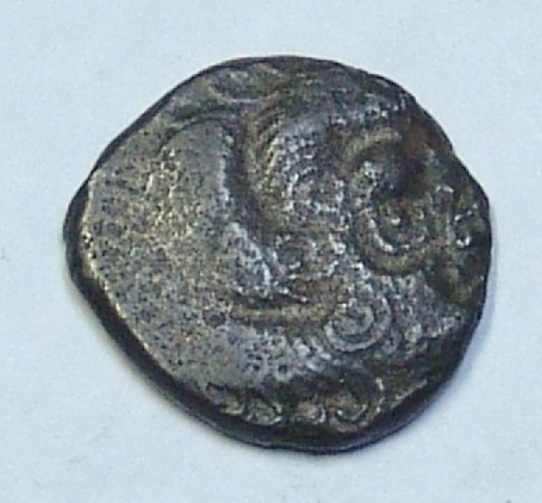
 | CELTIC. Amorica. c75-50 BC.
Channel Islands and NW Gaul. Billon stater. Seaby 15-17. Horse with
boar below, remains of driver with Victory above. Abstract Celtic
style, Good Fine. | $150 |
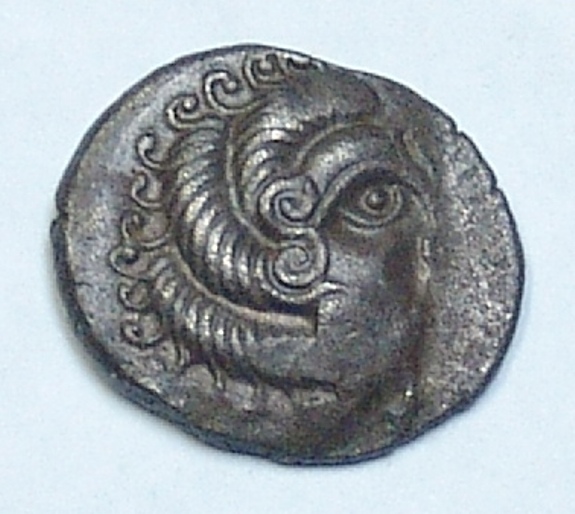
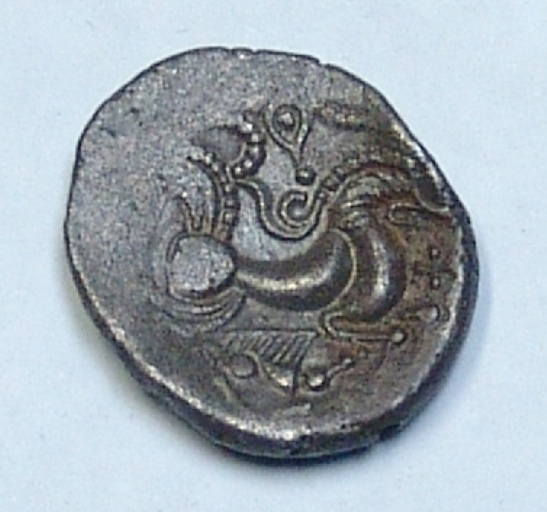 | CELTIC. Amorica. c75-50 BC.
Channel Islands and NW Gaul. Billon stater. (23mm, 6.26g) Seaby 15-17. Horse with
boar below, remains of driver with Victory above. Abstract Celtic
style, Good Very Fine. | $275 |
|
Click small photo to see larger image. |
Rare Dark Ages coinage
of the Huns, Vandals and Goths 480 - 650 AD.
For the not so dark ages, compare the generally crude
European issues of this period to some of the Byzantine gold from the same period
(circa 400-650 AD) listed in the "Later Roman Coins" section of this website. |
$ |
  |
OSTROGOTHS, Municipal Coinage of Ravenna, Theodoric (A.D. 536-554), AE ten nummi (decanummium)
(15mm, 2.012 grams), obv. bust of Tyche to right, around traces of
legend, FELIX AVENNA, rev. monogram of Ravenna all within wreath, (Hahn
MIB I 72a, Grierson & Blackburn MEC 145-150, BMC 36-38 [Pl.XIV,
10-12]). Light brown patina, good fine, scarce.
The Ostrogoths were one of a number
of Germanic tribes that ravaged the Roman Empire while under the domination of
the Huns. After the Hunnic kingdom fell in AD 454, the Ostrogoths were settled
in northern Pannonia as foederati. In AD 488, the emperor Zeno called on the
Ostrogothic king, Theodoric, to overthrow Odovacar, who had been ruling Italy
for the emperor, but had recently become an opponent. Theodoric complied, and
hostilities lasted until Odovacar was finally defeated in AD 493. Theodoric was
to rule Italy until the emperor arrived, but Zeno died before this occurred. As
a result, the Ostrogoths established their own kingdom in Italy, under the
authority of the emperor in Constantinople. Over the first thirty years, under
Theodoric and then his grandson, Athalaric, Italy experienced a period of
relative tranquility. The prosperity of the kingdom was shattered in AD 535,
when the Byzantine emperor Justinian I sent his general Belisarius to return
Italy to ‘Roman’ rule. Although Belisarius was on the brink of accomplishing
this goal, Justinian was forced to recall him to lead the imperial forces
against the Persians in the east. Afterward, a quick succession of inept kings
followed, until Baduila ascended the throne in AD 541. A popular king, he
restored most of Italy to the Ostrogoths and sparked a revival of their
fortunes, but was eventually killed in action against the Byzantines at Busta
Gallorum in AD 552. His successor, Theia, died that same year, and only a few
independent pockets of
Ostrogothic resistance held out until the last stronghold
was taken in AD 562. | $225 |
| Click small photo to see larger photo. | Later Anglo-Saxon period. England, Kings of Wessex and Kings of All England c850AD-1066AD. | $ |
  | ANGLO-SAXON Period, Kings of All England. Cnut (1016-1035 AD). (19mm, 1.08 grams.) London Mint, issued 1029-1035, moneyer Eadraed, obv. diademed bust
left with four horizontal folds and five vertical pellets to drapery, lis-tipped
sceptre before, +CNV T RE: around, rev. voided short cross with large pellet in
centre within inner circle, +EDRED ON LVND around, (S.1159, N.790, BMC
xiv). Toned, a few peck marks, nearly very
fine and scarce.
Ex S.J.Green
Collection. Previously Dix Noonan Webb Auction 173, lot 129. | $695 |
| Click small photo to see larger photo. | Normans & Plantagenets. 1066-1485. | $ |
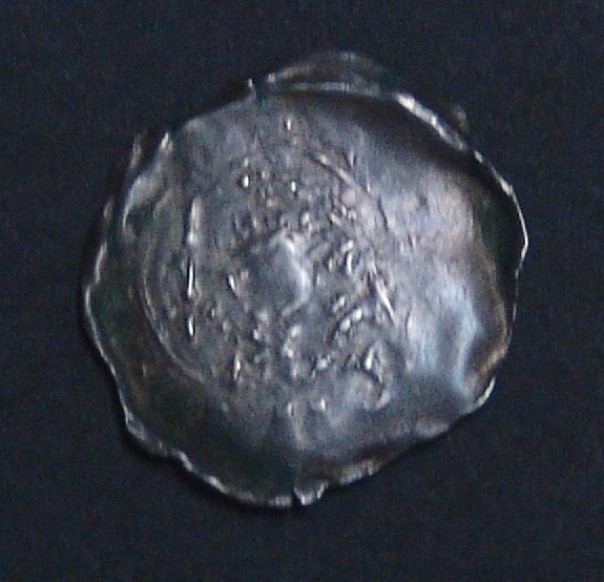


 |
NORMAN ENGLAND. Stephen. 1135-1154.
Silver Penny
(22mm, 1.40 g). Cross moline (Watford) type. Thetford mint; Rodbert moneyer. Struck
circa 1135-1141. +STIEFN[E R:], crowned bust right, holding scepter /cross moline; lis in angles. Seaby 1278.
Excellent portrait for this crude issue, VF for type, struck on a huge flan for
issue, which somehow missed the clippers, antique toning.
When Henry I died in 1135 he desired his daughter Matilda
(or Maud), married to the Holy Roman Emperor Henry V, to succeed him. But
Henry's nephew Stephen of Blois, Count of Boulogne, was the quickest to react to
news of the king's death and crossed the Channel to claim the throne. Matilda
rallied her own supporters and landed in England in 1139, sparking a 15 year
civil war, the Period of Anarchy. During this period many of the contesting
nobles struck coins in their own names. Matilda's uncle, king David of Scotland
invaded northern England in her support, but was defeated by Stephen at the
'Battle of the Standard" in 1138. To avert further hostilities, Stephen agreed
to name David's son Henry Earl of Northumberland, and left the north under
nominal Scottish control. Stephen was captured in 1141, but his supporters
continued the conflict. In 1153 when Eustace, Stephen's son and heir designate
died, the two sides reached an agreement to end the conflict. Stephen would
retain his kingdom for life and in return adopt Matilda's son, Henry Plantagenet
as the new heir. |
$950 |
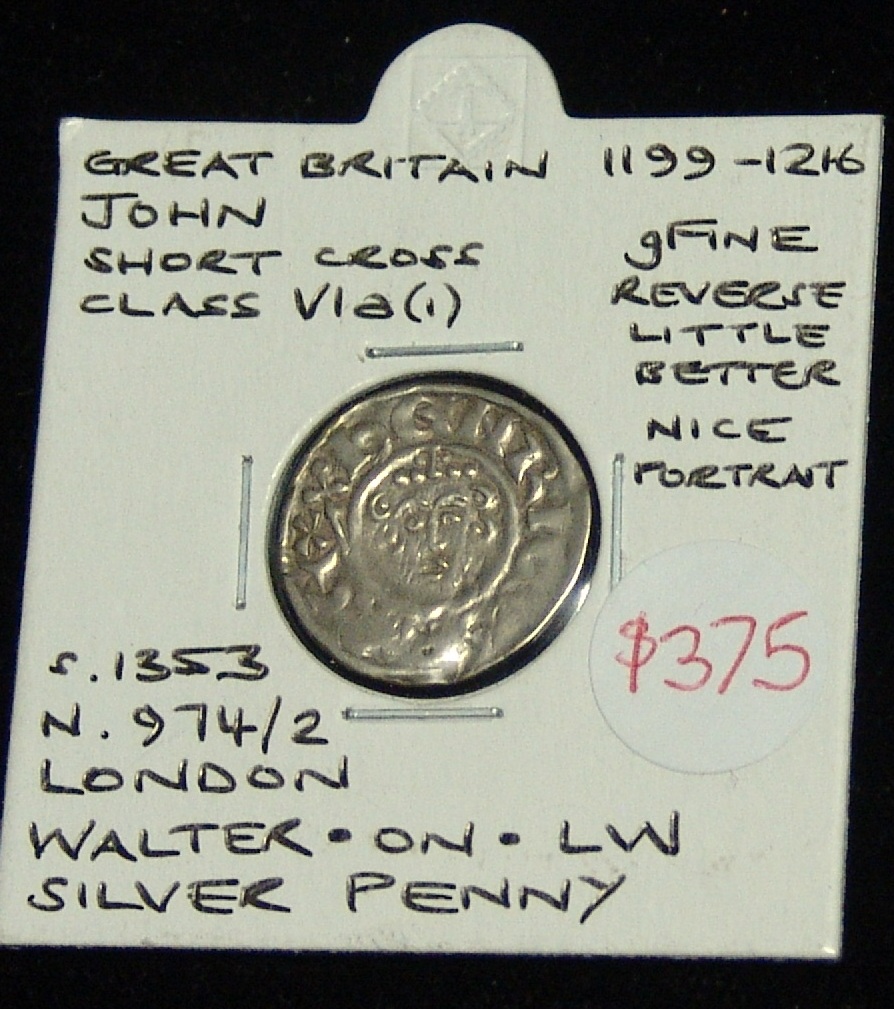
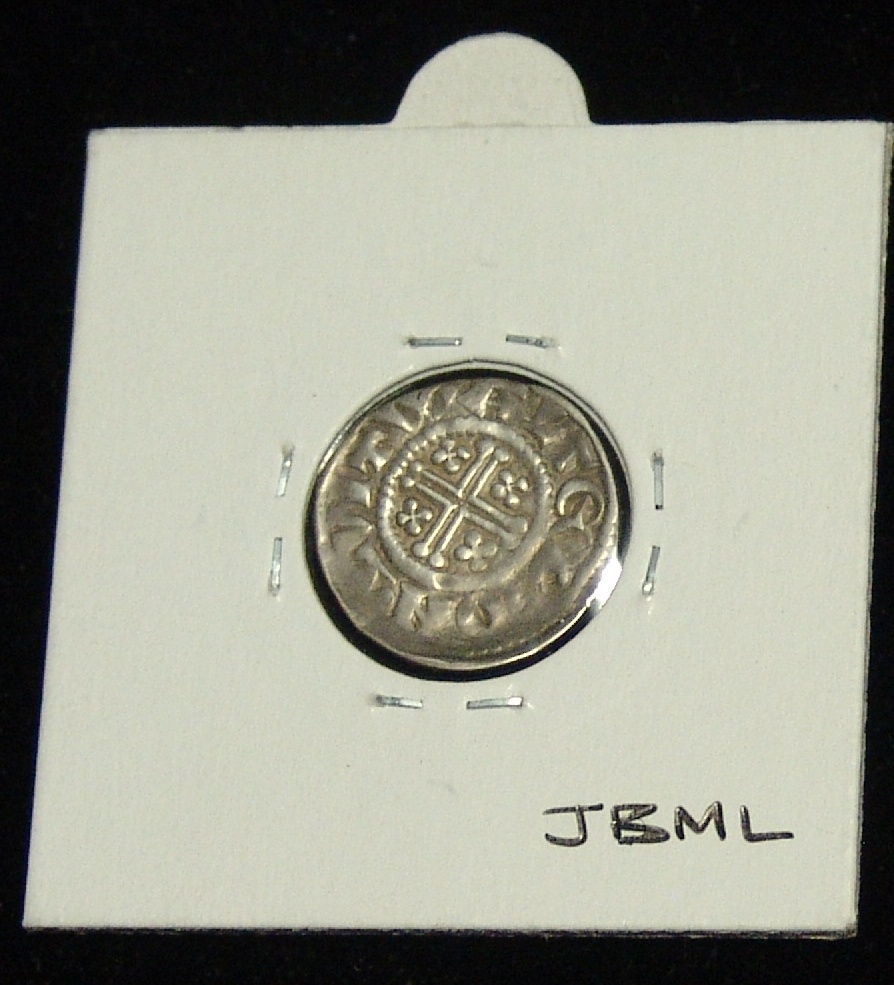 | ENGLAND - JOHN, (1199-1216AD), silver penny. Short
cross silver penny, Class VIa, Seaby 1353. North 974/2. Walter On Lw
Moneyer. Nice portrait, Good Fine and a historical figure. All John
coins have Henry titles. | $375 |
  | ENGLAND - HENRY III, (1216-1272), silver penny. Long cross type,
class Vb2, Canterbury Mint, moneyer Gilbert of Bonnington, (1.51 g),
obv. facing narrow but tall bust, rev. voided long cross dividing legend around,
with trefoil in each quarter within pelleted inner circle, (S.1368,
N.992/2) Toned, near VF.
Ex SJ Green collection with tickets. | $165 |


| ENGLAND - EDWARD III, (1327-1377), silver penny, pre treaty
series C, Durham Mint, (1.13 g), obv. crowned facing bust within
pelleted circle, trefoil of pellets on breast (rare), square initial
cross pattee, no stops, reversed barred Roman N, rev. long cross pattee
voided dividing legend, crozier before CIVI, trefoil of pellets in each
angle, no stops, reversed barred Roman N, (S.1592, N.1150). Toned, Near VF.
Ex S. J. Green Collection. With tickets.
Previously Spink Auction 17006, lot 734 | $195 |
  | ENGLAND. Edward III, (1327-1377)
Bronze Dassier memorial medal, 39mm, made in the 18th century, near as struck. | $100 |
 |
BULGARIA, Second Empire. Ivan Sisman.
1371–1395.
Silver Half Grosh (14mm, 0.48 g). Type IV. Turnovo mint. Half-length
facing bust of the Theotokos, ,i>orans, facing bust of Holy Infant on breast;
[M] Q flanking / Ivan standing facing, holding
scepter; W to left, W/monogram to right. Raduchev & Zhekov 1.15.11; Youroukova &
Penchev 127. Good VF, attractively toned. |
$75 |
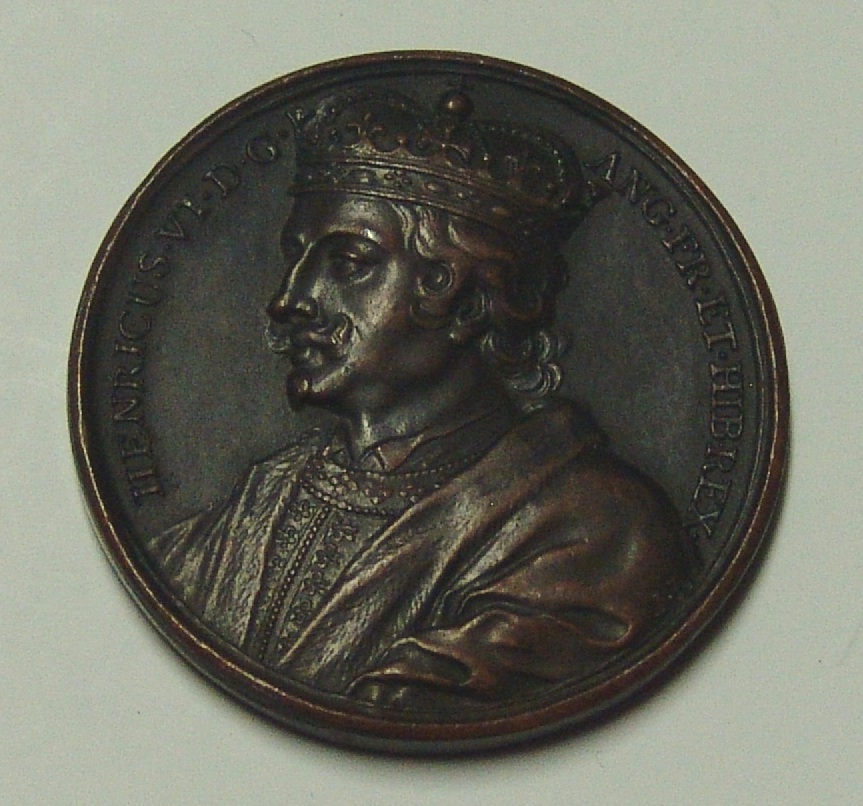  | ENGLAND. Henry VI. 1422-1461. Death Medal.
(38mm) By Dassier, bronze, produced in 1731 as part of a series of medals commemorating the Kings and Queens of England, EF. | $85 |
| Click small photo to see larger photo. | The Tudor Dynasty 1485 to 1603. | $ |
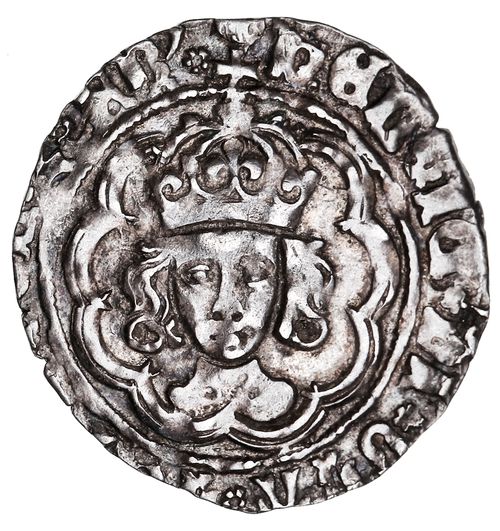  | ENGLAND. Henry VII, (1485-1509) Silver Half Groat.
S
2210. Canterbury Mint, MM Tun/lis. Obv. Crowned facing bust within tressure of arches, no cusps.. HENRIC DI GRA REX
ANGL Z FR around, rev. POSVI
DEVM ADVITORE MEVM CIVITAS CANTOR on two concentric cirles, long cross
pattee dividing the legends, in each angle a trefoil of pellets,
rosette stops on reverse legend. Toned, VF, scarce ruler. | $475 |
  | ENGLAND. Henry VIII, (1509-1547) silver groat. 2nd coinage, S 2337E. Well struck with attractive tone, gVF for type and scarce. | Sold |
  | ENGLAND.
Henry VIII, 1509-1547. Dassier
Commemorative Medal, 40mm, 41.5g - a modern copy struck in lead.
Interesting, about as struck. | Sold |
 | ENGLAND. Edward VI, 1551 Half Crown.
S 2479. Galloping horse with plume, about Fine and very rare. | Sold |
 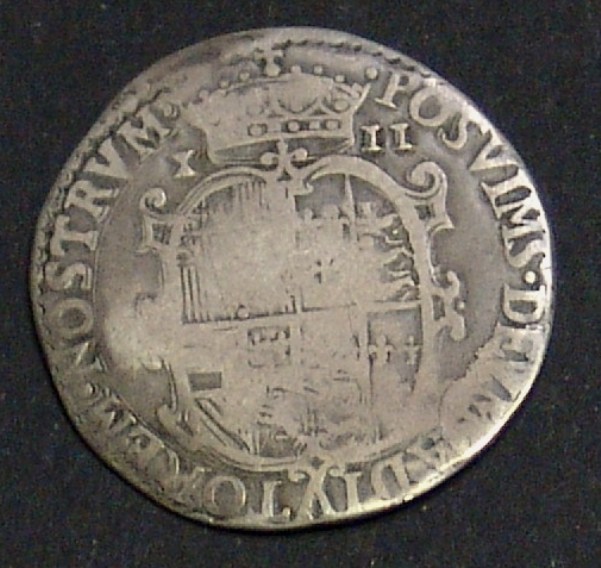 | ENGLAND. 1554-1557 Philip & Mary silver shilling. Undated type, Seaby 2501a. Very nice portrait coin, obverse more worn, F/VG. Very hard coin to get with a decent portrait. | Sold |
  | ENGLAND. 1560-1561 Elizabeth I shilling.
Seaby 2555, 2nd issue, mm Cross Crosslet. Visible portrait, VG. | $125 |
  |
ENGLAND.
Pre - James I Gold coin weight in lead. Value of 16/6d.
With crown, value and castle counter - stamp. Reverse shows intricate coat of
arms. W 400. Some stains, sharp detail, overall VF and an interesting addition to your gold coin
collection. |
$50
|
| Click small photo to see larger photo. | The House of Stuart & The Commonwealth of England. 1604 - c1690. | $ |
 |
ENGLAND. James I.
Coin weight for Ryal (30/-) 18mm, struck one side only or uniface, Fine and scarce. |
$50 |
  |
ENGLAND. James I
1603-1625 Gold
unite coin
weight in brass. Crown and
value XXII for 22/-. W796. Also has portrait of James I. Well
used, grades VG/G. Interesting. |
$50
|
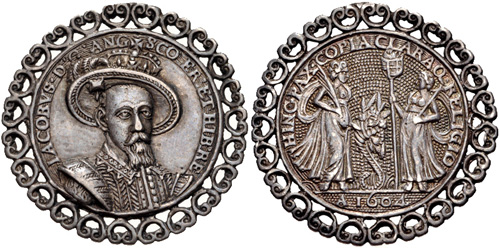
| ENGLAND.
STUART. James I. 1603-1625. Silver Medal.
(41mm, 12.13 g). Commemorating
the Peace with Spain.
armored
bust facing slightly right, wearing crowned and plumed hat,
jewel under the brim, and fallen lace collar / HINC · PAX
· COPIA CLARAQ · RELIGIO, Peace standing right,
holding palm branch over shoulder and cornucopia set on ground,
facing Religion standing left, holding beacon and cross over
shoulder; A 1604 in exergue. Hawkins p. 194, 15. Good VF, toned,
very rare.
Medal
housed within ornate open-work frame, the loop for suspension
having been removed. | $1250 |
 | ENGLAND. Charles I (1625-1649) Silver Half Groat. Struck 1636-1638.
Tower mint. MM: Tun. Seaby 2831, Near VF for type. | $150 |
 | ENGLAND. Charles I (1625-1649) Silver shilling. Struck 1636-1638.
Tower mint. MM: Tun. Seaby 2791, VF for type. | $295 |
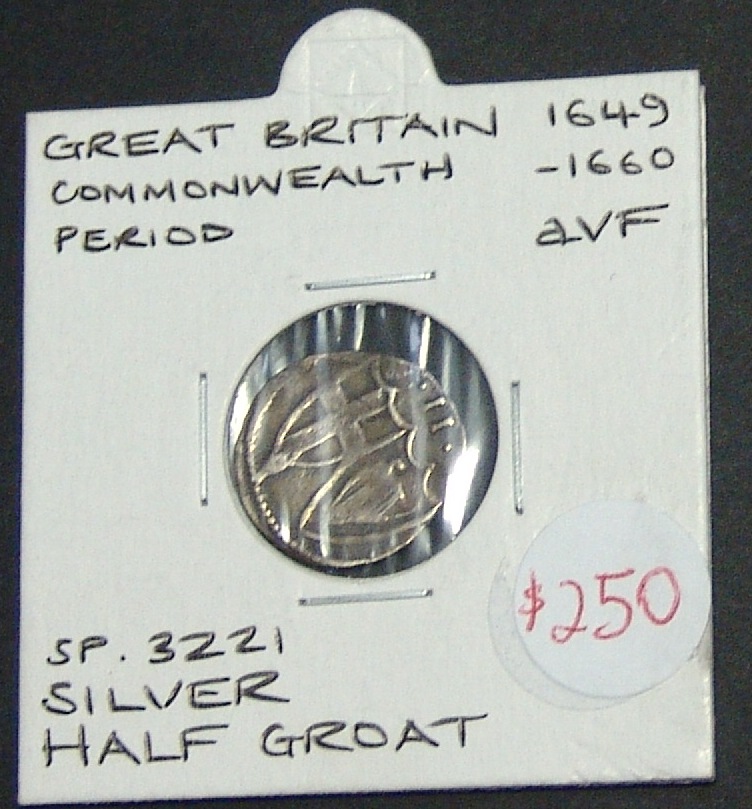
 | ENGLAND. Commonwealth 1649-1660 period silver Half Groat.
16mm diameter, Seaby 3221. Near VF and scarce. | $250 |
 |
ENGLAND.
Oliver Cromwell memorial Medal. In silver by Dassier, circa 1731,
38mm, 30.4 grams. Scrape on cheek, otherwise EF or better, very rare.
| $450 |

 | ENGLAND.
1733 Oliver Cromwell commemorative Medalet.
26mm, bronze with portrait of Cromwell, Very Fine and scarce. | $175 |
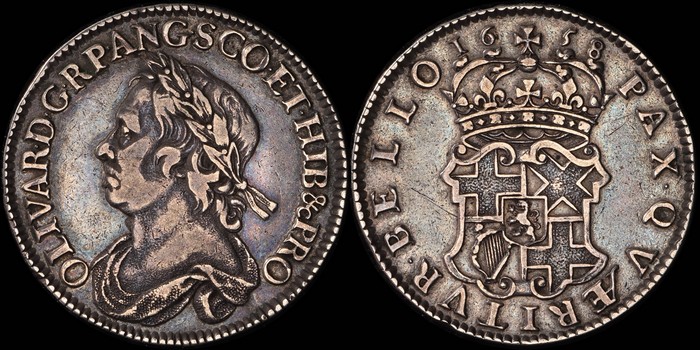 | ENGLAND.
1658 Oliver Cromwell half crown. S 3227a, 14.89 grams, evenly toned mid grade, VF, very rare. | Sold |
| ENGLAND. 1660-1670 Token Merchant coinage. During
this period, merchants were allowed to make their own small change of
halfpennies and farthings. A quirky, interesting series. | |

 | ENGLAND.
Buckingham, Bucks, Halfpenny,
1668 John Rennals, strip of lace (D.36a) Rare with John Watson farthing
1653 of Gravesend, Kent, arrow piercing heart (D.308) Fine.
William Hale halfpenny 1662 of Tewkesbury, Gloucestershire (D.187) VF.
London farthing, circa 1650, The Willow Tree Pub, Olde Change (D.2127) VG, rare.
4 coins in group | $225 |

 | ENGLAND.
The Borough of Yeovil, halfpenny token, 1668
aVF, The Port Reeve halfpenny: with Norwich Towne halfpenny 1667 Fine;
Bristol town Halfpennies 1652 and 1670 VG; Andover Town farthing 1652
poor, Great Yarmouth town farthing 1667 poor; London farthing, C.Nixon
at the New Crane, VG, holed; Lincoln farthing, Joseph Ludington at the
Bale (D.153) about Fine; Beaminster, Dorset farthing Henry Brayne 1657
VG. An interesting group, 9 coins. | $195 |
| | |